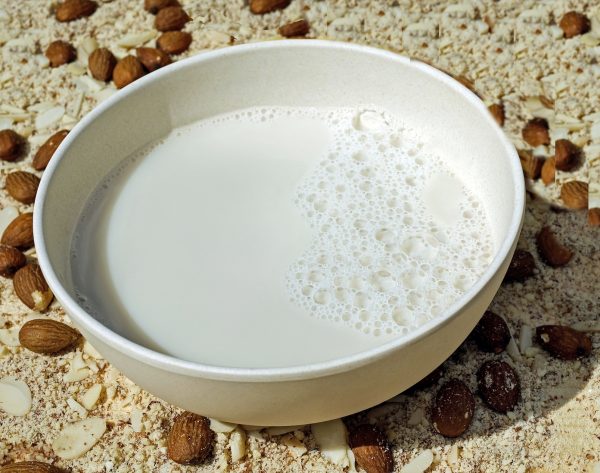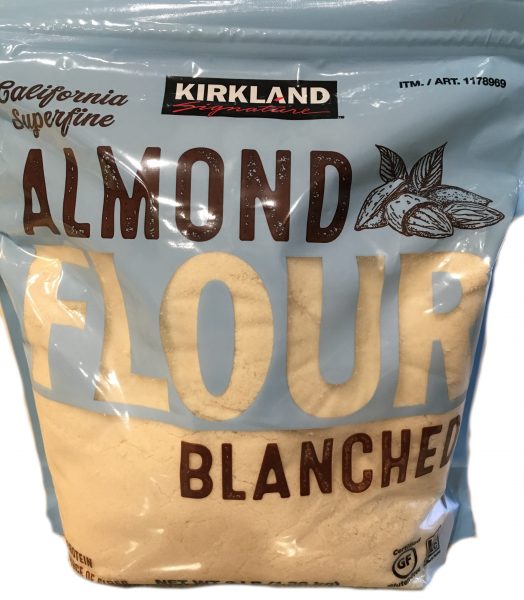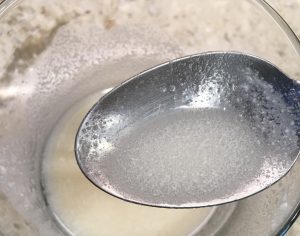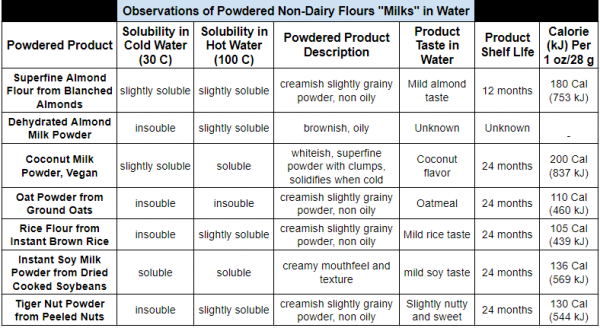The market for non-dairy milk has exploded over the last few years, and that’s great news if you don’t consume cow’s milk. There’s now a multitude of alternatives to choose from, including almond, cashew, coconut, hemp, oat, rice, and soy.
But when it comes to powdered non-dairy milk, it’s difficult to find anything besides soy or coconut. With the popularity of fresh almond milk, it’s surprisingly difficult to find a powdered version. Here we studied why this is the case and present our findings.

Almond Milk Powder
Although California is the largest producer of almonds in the world, there is no such product as almond milk powder in the United States (see below if you are in NZ or Spain). The closest match you’ll find in the U.S. is almond flour — specifically, a superfine grind of almond flour made from blanched almonds. You can find almond flour in the baking section of grocery stores.

Making Almond Milk from Almond Flour
When superfine almond flour is stirred in water to make almond milk, it doesn’t fully dissolve, so don’t expect a creamy consistency like powdered soy milk. If you’re using it for cereal, the fact that there are tiny suspended nut particles shouldn’t really matter. It adds calories, flavor, and texture, and that certainly beats plain water. Tastewise, almond flour milk is blander than fresh almond milk. Much of the naturally sweet almond flavor gets lost in the drying, although adding a small amount of vanilla powder, salt, and a sweetener helps.
If you make your own trail meals, take note that blanched almond flour has a decent shelf life, from 6 to 12 months. Some almond flours are produced from partially defatted almonds to extend shelf-life, but that will also reduce the calories. The nutritional content of the bag we purchased was 180 Calories per ounce (28 g) or 1/4 cup dry.
Overall, we think superfine almond flour “milk” is a suitable alternative to soy and coconut milk powder.

Making Almond Milk Powder from Liquid Almond Milk
If you want actual almond milk powder (i.e., evaporated almond milk), you’ll have to make it yourself by drying liquid almond milk. As a test, we created and dried our own almond milk.
The method: Soaked the almonds for 12 hours until soft and plumpy and discarded the soaking water. The next day, we blended the almonds with a small portion of water until it resembled a thick slurry. Next, the mixture was strained through a mesh nut milk bag to eliminate the fibrous pulp. The liquid was placed on a dehydrator sheet and dried at 135 degrees F for 16 hours. The result was an unappealing sticky brown powder.
Based on our limited one-time test, we can’t recommend drying fresh almond milk. In fact, we don’t recommend drying any liquid nut milk, especially commercially prepared nut milk.
Commercial nut milk is mostly water. In the case of almonds, it is made by blending water with a small number of almonds (typically 2%*) and straining the fibrous pulp away. The result is a watery mixture that is thickened, emulsified, and fortified to resemble the viscosity and nutrition of cow’s milk. In fact, the milky-white coloration of most commercial nut milk comes not from the meat of the nuts (too few are used), but from the calcium carbonate.
The white coloration is a beneficial side effect, although this is not the reason why calcium is added to nut milk. Rather, this mineral is added to boost the calcium content. While almonds are a reasonably good source of calcium, almond milk is not naturally high in this mineral because not enough almonds are used in making the milk.
Commercial Nut Milk Powder Cons:
1. Poor Solubility
Nuts have a high concentration of fat and fiber, both of which are insoluble in water. Dairy milk powder dissolves easily by stirring in cold water because, unlike nut and legume milk, it started off as a fluid. In other words, dairy has no solid vegetable matter. Processing it to a powder simply involves evaporating the water until milk solids form. Reconstituting powdered dairy milk is easy, you stir in cold water, and it dissolves. On the other hand, plant-based powders contain fine grinds of vegetable solids that don’t dissolve when mixed in cold water. Some varieties (see chart) will dissolve okay in hot water, however.
So there you have it. While powdered dairy milk dissolves in water, most powdered plant substitutes don’t. The only way to improve cold and hot water mixing of plant-based milk powders — to make them instant — is to apply further processing via defatting, emulsifying agents, and fiber reduction. This added processing alters the taste. Thus, more ingredients must be added to bring back the lost flavor. Most people don’t want the added ingredients.
2. Poor Storage Life
Nut powders have a short shelf life, often maxing out at 12 months. The reason is due to the high content of moisture and oil from the nuts. Nut oils are more sensitive to heat and oxygen than oils coming from fruit drupes, such as coconut. Nuts can be partially or fully defatted to extend shelf life but this removes much of the flavor. Other ingredients such as sugar, salt, and vanilla are often added to improve the taste. Also, for hikers, low-fat powdered milk isn’t worth carrying because it is a low-calorie food.
Final Thoughts
If you need a dairy milk substitute, know there are a range of options available in liquid formats, not dried forms. This may change as more humans give up the strange tradition of drinking the milk of another species. A cow lactates milk to grow a calf, not unlike a human infant drinking human milk. Lactation is a temporary biological process, and animal milk should not be a lifelong food source.
may change as more humans give up the strange tradition of drinking the milk of another species. A cow lactates milk to grow a calf, not unlike a human infant drinking human milk. Lactation is a temporary biological process, and animal milk should not be a lifelong food source.
If you are looking for powdered plant-based milk, consider these three:
Coconut Milk Powder
Coconut milk powder is made from spray-dried coconut cream rather than a fine grind of the fibrous coconut meat so it has decent solubility. Due to the high saturated fat content, it hardens during cold weather. Be aware that some coconut milk powders contain sodium caseinate (a milk derivative of casein), which makes it unsuitable for vegans.
Soy Milk Powder
Soy powder is made from spray-dried soybeans that have been cooked and strained. Soy’s natural proteins provide a rich and creamy consistency with a sweet taste that closely matches the mouthfeel of cow dairy. It dissolves well in hot or cold water.
Almond Milk Powder
Almond milk powder is super fine almond flour made from blanched almonds which doesn’t dissolve water. You can also use unblanched almond flour which means the almond skin remains intact and you’ll have specks of brown floaties.
How about oat powder, rice powder, tiger nut powder? Here we compare alternative milk powders based on several factors: cold water solubility, hot water solubility, shelf life, nutritional content, and taste.
*Homemade nut milk commonly contains a ratio of 25% nuts to water, yielding a naturally thick and milky white beverage. Commercial nut milk does not contain nearly as many nuts, often 2% to keep costs low.

4 thoughts on “Powdered Non Dairy Milks for the Trail”
Great and informative article!
Glad you enjoyed it, Jason!
Goat milk powder is a good alternative and mixes well. Look also at the infant formulas
Does this mean all these years we should not ever use cows milk ? If you cannot breast feed no formula? Poor babies